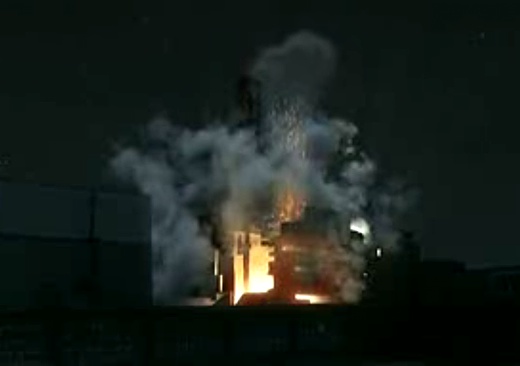By Raul Ilargi Meijer on 26 April 2011 for Automatic Earth -
(http://theautomaticearth.blogspot.com/2011/04/april-26-2011-race-to-bottom-goes-to.html)

Image above: Still from "Battle for Chernobyl" (see below) showing nuclear explosion in reactor building. It is similar looking to the explosion in Fukushima Dai Ichi Reactor #3 which contained MOX fuel and suffered an explosion different from Reactor #1.
As we remember the 25th anniversary of Chernobyl, it's getting clearer by the day that the level of secrecy exercised by Tepco, the Japanese government, and its international allies, rivals that of the Russian government 25 years ago. And the way things are going, Fukushima may soon surpass Chernobyl in the "secrecy files".
When it became clear that Chernobyl had spewed its radioactive clouds up to thousands of miles away, for instance to Scandinavia, at least the Russians went in with all they could muster, deploying the full force of the army plus tens of thousands of "volunteers". Japan today, on the other hand, is still mired in the denial phase. Which is becoming increasingly dangerous. There are increasingly reports coming out that claim that at least one of the explosions witnessed at Fukushima was not a hydrogen blast, but a nuclear explosion -in a spent fuel pool-.
And while there won't be an instant runaway reaction like the one at Chernobyl, simply because the reactor design doesn't lend itself to it, this should be reason enough for grave concern (as well as transparency, of course, but don’t hold your breath on that one). And there are other twist emerging. Professor Chris Busby, scientific secretary for the European Committee for Radiation Risks, states that a major difference between the two disasters lies in the amount of people living close to the blast site. So while the radioactive parts spread over a far smaller area, the immediate surroundings of Fukushima contain far more people. And Tokyo must by now even be greatly concerned about, well, Tokyo.
Which may well be a major reason for the ongoing "policy" of continued opacity as executed by Japan. Prof. Busby points to yet another issue that Tokyo is running up against: in his view, because there's still nuclear fissioning taking place at Fukushima, placing a sarcophagus over the reactor sites has no use, since -highly- radioactive material will then simply leak out into the ground and flow out to sea. Japan's answer?
An underground wall is being considered. They'd do much better to come clean on what’s actually happening -and what already has-, send in their army with all it's got, and get the smartest minds in the world together to try and find the best way forward. But since Japan has always been a highly secretive society, and the international nuclear industry is as powerful as it is rich, it's far more likely that they will continue to play down the impact, until they can't anymore, and the situation gets completely out of hand, so much so that Fukushima will indeed stand a chance for competing with Chernobyl as the worst nuclear incident ever.
Video above: Interview with Professor Christopher Busby on the 25th Anniversary of Chernobyl. From (http://www.youtube.com/watch?v=x-3Kf4JakWI).
Video above: "The Battle for Chernobyl". From (http://www.youtube.com/watch?v=Wv3a4LXi_qc).
.
No comments :
Post a Comment